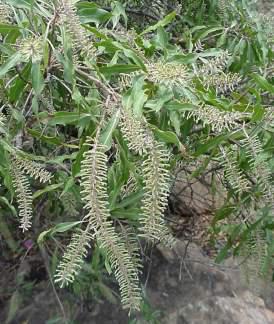Faurea saligna
Faurea saligna Harv.
Family: Proteaceae
Common names: willow beechwood, African beech (Eng.); Bosveldboekenhout (Afr.); iSefu, umCalathole (Zulu); isiDwadwa, umOnyeli (Ndebele); mohlako, mongena (Northern Sotho); muTango (Venda)
SA Tree No: 75
Introduction
The willowy shape of Faurea saligna is a graceful feature in large gardens and landscapes, and its resistance to termites is a bonus, especially in Gauteng.

Description
Description
Faurea saligna is a small, willowy tree, 7-10 m tall but reaching up to 20 m in KwaZulu-Natal. The trunk is slender and straight, and the bark is dark grey to black.

The leaves are long and narrow, almost hairless, 65-125 x 13-20 mm, lanceolate-elliptic, slightly sickle-shaped, drooping and waxy. The leaf margins are entire, green in summer and red in autumn. The leaf stalk is 20 mm long. It resembles the karee tree, Searsia lancea ( = Rhus lancea) , but it does not have trifoliate leaves.
It flowers in spring around September.The flower heads are formed in slender spikes, 120-150 x 20-30 mm, green to creamy white. The flower heads are borne at the branch tips and have a honey or coconut scent. The flowers are 12 mm long and are densely covered with adpressed, grey hairs when young.

The fruit is a small nut with hairs. It is a moderately slow grower.
Conservation Status
Status
Faurea saligna in not threatened as it is common and well distributed. It grows in large populations.
Distribution and habitat
Distribution description
Faurea saligna occurs in the northeastern part of southern Africa from Zimbabwe, Mozambique, down to North-West Province, Gauteng, Limpopo Province, Mpumalanga, Swaziland and KwaZulu-Natal. Faurea is the only genus in the Proteaceae that is not endemic in the southwestern Cape.
It occurs in sandy or red loamy soils, and on rocky ridges. It tolerates low to medium altitude and rainfall of 508 mm per annum. It is sensitive to cold, but will thrive in areas with a mild winter.
Derivation of name and historical aspects
History
The genus Faurea was named by Harvey as a tribute to the memory of a young soldier, who was enthusiastic and passionate about botany, W.C. Faure, the son of a minister of the Dutch Reformed Church in Cape Town. He was killed in India by an unknown person while on his way to the regiments.
The specific epithet saligna means resembling a willow tree, referring to the drooping leaves and flowers. This tree received its common name boekenhout or beech from the resemblance of the wood to that of the European beech tree. There are about 15 species of Faurea in Africa and Madagascar, of which six species occur in southern Africa. F. rochetiana is another attractive tree in this genus.
Ecology
Ecology
The wood is not susceptible to borers and termites.
Uses
Use
Faurea saligna wood is good for furniture. It is also used to make poles. The first telephone poles between the old South African Republic and Natal were mainly African beech poles (Palmer & Pitman 1972). The wood is resistant to termites. It also makes good firewood. A red dye is made by soaking Faurea saligna in water. This is a very decorative garden tree.

Growing Faurea saligna
Grow
Faurea saligna is grown from seeds and germinates well. Sow seeds in summer in a well-drained soil medium. This tree is suitable for large gardens as it eventually grows into a big tree, so it is not suitable in areas with a limited space for spread. It can be grown successfully in more temperate regions, such as Pretoria, the Lowveld and KwaZulu-Natal.
References
- Coates Palgrave, M. 2002. Keith Coates Palgrave Trees of southern Africa, edn 3. Struik, Cape Town.
- Palmer, E. & Pitman, N. 1972. Trees of southern Africa. Balkema, Cape Town.
- Rebelo, A. (Tony) 2001. A field guide to proteas of southern Africa. Fernwood Press & National Botanical Institute, Cape Town.
- Rousseau, F. 1970. Proteaceae of South Africa. Purnell, Cape Town, Johannesburg, London.
- Van Wyk, P. 1984. Field guide to the trees of the Kruger National Park. Struik, Cape Town.
Credits
Giles Mbambezeli
Kirstenbosch NBG
June 2008
Plant Attributes:
Plant Type: Tree
SA Distribution: KwaZulu-Natal
Soil type: Sandy
Flowering season:
PH:
Flower colour:
Aspect:
Gardening skill: Average
Special Features:
Horticultural zones








Rate this article
Article well written and informative
Rate this plant
Is this an interesting plant?
Login to add your Comment
Back to topNot registered yet? Click here to register.